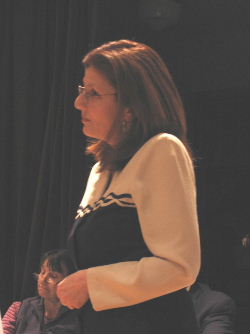 |
|
A Tree Will Grow in Spring Glen
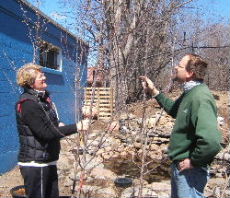
Anne Pepe and Jeff Allard of the Hamden Garden Center look at baby trees to line the "hostile" streets of Spring Glen. Photo/Sharon Bass
By Sharon Bass
Ann Baker Pepe doesn't like what she sees in her Spring Glen neighborhood. She also doesn't like what she doesn't see.
"A lot of trees have died over the years or are dying," she said. "You can walk in Spring Glen past four or five houses in a row and see no trees."
Trees at the brink of death and vacant green spots which trees once filled drove the 18-year resident to find a fix. She found it in her own back yard: the Spring Glen Civic Association, of which she is a member. The neighborhood group decided to offer members $50 apiece if they buy an $80 tree at the Hamden Garden Center. The deal includes having the tree planted on the apron between the street and sidewalk, in a spot the buyer chooses. The association has allocated $2,000 -- or enough for 40 members -- for the tree effort.
"Many of us have chosen to live in Spring Glen in part because of the beautiful tree-lined streets that characterize our neighborhoods," said Pepe. "But if you really look along the streets you see that many trees have died off. Others have been removed but not replaced."
Garden center owner Jeff Allard came up with seven types of trees likeliest to do well, for the neighborhood project. A former Clean and Green commissioner, he helped author the town's street and park tree list and gets some town business.. The trees he chose for Spring Glen are 6 feet to 8 feet tall. Red and sugar maples, Crimson King Norway maple, linden, sycamore, ornamental cherry and crabapple made the cut.
"It's a hostile environment," Allard said of the Spring Glen streets. Pedestrian traffic, road salt and sand and the lack of moisture in the strip of grass between the sidewalk and street are the enemies.
While he chose trees that have the best shot at surviving under those conditions, Allard said their fate is uncertain.
"You can't determine whether they'll be any better" than what was there before, he said. Then added, "Sycamore is a very stress-tolerant tree, salt-tolerant, moisture-tolerant."
Off-Campus QU Housing, Continued
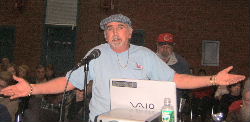
Richard Famiglietti said he's fed up.
Story and photos by Sharon Bass
A community-activist group that formed to battle the growing encroachment of college students on the town's suburban neighborhoods held its second public meeting yesterday evening in Thornton Wilder Hall. Unlike its Jan. 5 gathering -- designed to be a vent session -- this time Concerned Citizens for Hamden Neighborhoods was looking to beef up membership and share the progress it's made in combatting the problems of off-campus housing.
While the audience was told this was not another gripe session about Quinnipiac University students, the issue is so volatile that some folks felt the need to get up and vent anyway.
About 200 to 300 people filed into the hall to listen to CCFHN founder and co-president Joanne Iacobellis, co-prez Lester Faiman, Assistant Town Planner Dan Kops, Mayor Craig Henrici and Police Chief Jack Kennelly. It was made clear that no Quinnipiac officials were at the meeting as they weren't invited.
"This all began back in October at Eli's," Iacobellis opened the meeting, "when four of us met about student housing. Since then, we've developed bylaws, a database [of about 400 off-campus student houses] and are working on a Web site. Tonight we will talk about solutions."
Faiman said there's been a 40 percent growth in QU undergrad students, creating a shortfall of 2,400 on-campus beds. The town Planning Office is now fully staffed, he said, including two enforcement officers to investigate homes where students live that don't have permits for such use. He implored the audience to report any suspicious houses.
"This is your town," said Faiman. "Let's put the students back on the campus and our homes back as our castles." He received a thunderous applause.
"We must prevail. We must not be intimidated. Remember, we live here. We're not just here for four years," he said.
When he finished speaking he asked if anyone had questions.
Kay King of School Street had something to say. She walked over to the microphone stationed in the middle of the room. There is a house on her street that has eight bedrooms, she said. Each room rents for $1,000 a month. King called it "Animal House."
Tom Harberg of Vine Street said someone is buying the house across the street from him and is about to rent it to "a bunch of kids. There are students already lining up to move in there," he said. The audience moaned.
"How many calls does it take the police to come?" asked Richard Famiglietti of Cannon Street. He complained about student cars parked all over his street.
"The issues are bigger than student housing," said Fred McCarthy of West Todd Street. "There are 18-year-olds driving drunk. There are 18-year-olds drinking on campus. Where does Quinnipiac get off letting 18-year-olds drink?" He said the university should have its own police force.
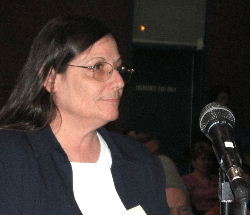
Patty Tucker of CCFHN.
Patty Tucker, a CCFHN officer, asked how people can determine if more than four students are living in a house. Local zoning law allows no more than four unrelated adults to inhabit the same dwelling.
"Good question," said Kops. "It's what you see. We need your help."
There's Hope
Mayor Henrici delivered "good news." He said he's been having "frank but cordial" meetings with university officials, and presented their plan to develop more undergrad housing.
By this September, Quinnipiac expects to purchase the Whitney Village Apartments and turn it into a dorm. 145 more beds.
By September '07, there should be another dormitory on the Mt. Carmel campus. 336 more beds.
And by the beginning of the 2008 school year, Quinnipiac hopes to have new apartment-style housing on Sherman Avenue. 1,867 more beds.
"We want level enrollment," the mayor said. "It's good news. The plan may not be perfect for everybody. And we're taking Quinnipiac at its word." Next month, Henrici said, the school will hold a public meeting to officially announce its housing plan.
Quinnipiac spokesman John Morgan e-mailed this statement to the HDN: "University officials have been meeting regularly with Mayor Henrici and his administration to discuss possible solutions to the concerns raised by local residents. Those meetings have been extremely productive and we look forward to continuing to work with the mayor's office."
Town Planner Visits West Woods
Leslie Creane. Photo/Betsy Driebeek
By Betsy Driebeek
Town Planner Leslie Creane brought good news to the West Woods Neighborhood Association last night.
"I have an important announcement. We are fully staffed for the first time since I've been working in Hamden. We don't just have warm bodies but experienced and dedicated people," she said.
Creane was the guest speaker at the association's monthly meeting.
She said she wants to rewrite the town's zoning regulations. They have not been overhauled since 1982 but have been amended 60 times since.
In 2004, the town adopted a Plan of Conservation and Development. It represents a broad vision of what people want to see for Hamden in 10-year intervals, giving direction to both public and private development.
"Revising the zoning regulations is a natural follow-up to enforce the plan," Creane said.
Hamden's existing regulations follow the "use base" theory -- every building on every plot of land is allowed one type of use and that use depends on location, she said. Creane said she'd like to see "form base" theory incorporated into new regulations. These look at planning and zoning in a more comprehensive way, possibly allowing different uses by floor. "Not every use is incompatible with one another," she said.
The town planner said residents' input would be part of the revision process. They would be asked what they like and dislike about their area, what they never want to see happen to it, what would enhance it, what they want to get rid of, and so on.
Creane, who said she could complete an overhaul in maybe two years if she was not running the department, has requested money for a consultant to begin in July.
Switching gears, she told her West Woods audience that Mayor Craig Henrici, Assistant Town Planner Dan Kops and she have been meeting regularly with Quinnipiac University officials to talk about student housing, the growth of the university and getting students out of the neighborhoods.
"In three and one-half months there has been enormous progress," she said. "Quinnipiac University is just as accountable to our zoning regulations as anyone else."
For insomniacs, Leslie suggested logging onto the P&Z Web site to read the Plan of Conservation and Development or Hamden's zoning regulations.
In the general business portion of the meeting, WWNA president Al Dobie brought up the defeat of the hotel proposal at 55 West Woods Road.
"It shows what happens when our people show up in force and make presentations," he said.
But the developer has a lot of money, he said. He could challenge the decision in court and submit another proposal for that site for a hotel or office or shopping complex. He's talked about those possibilities, Dobie said.
He also praised the group for its efforts in stalling the reconstruction of the historic Mount Carmel bridges until an agreeable plan could be worked out. "When [the town] first started [the rebuilding process it] was ready to go forward, and now they are nowhere near that after all the research and testimony given by members and neighbors of our association," he said.
"I hope we all stay vigilant and concerned," said Dobie.
Newhall Tells it to the Commish
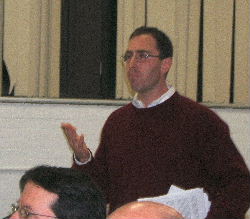
Keith Darden says his neighborhood wants a resolution -- now.
Dozens turn out to push the DEP to get moving on the cleanup
Story and photos by Sharon Bass
Gina McCarthy got peppered with questions last night from angry, frustrated people who live in Newhall. The folks who live atop the Winchester gun factory dump, but weren't told about it when they bought their homes. The ones who have been waiting years for the state to clean up the contaminated soil beneath their homes, their parks and the middle school.
Commissioner McCarthy, of the state Department of Environmental Protection, took the brunt even though she's only been on the job for a year. In fact, she's only been in the state that long. She spent the last quarter-century toiling for the Commonwealth of Massachusetts.
She came to the Keefe Community Center to get the final input from the Newhall Advisory Committee and the public before the state concocts a cleanup plan. And input she got. Particularly from NAC member Abdul Hamid.
"I really hope you take everything these people have to say seriously," said Scott Jackson, the mayor's chief aide, rushing out to see his newborn son.
Over and over, people said they want a complete cleanup. They don't want the contaminated dirt thrown behind the middle school. They want compensation for their "sinking homes" and for the loss of real-estate value since their neighborhood has been stigmatized. They want to know if there's a health risk because some neighbors have gotten cancer.
Most of all, they want the remediation to start ASAP. They've waited five or six years. They made it clear last night their patience is on overtime.
"I'm sorry the neighborhood has had to go through this," said McCarthy. "It really is time to move forward. I will be here until everybody has spoken."
State Rep. Peter Villano (D-Hamden), who sits on the NAC, said, "This is a message we've been hearing for the last five years." He urged NAC Chair Kathleen Conway to allow Hamid to speak freely.
"I see strain on people's faces. Are we going to have cancer? What will happen to us?" Hamid said facing McCarthy, their eyes meeting. "We are not two parties fighting against each other. We want what's the best for us. We want the community clean."
He painted a picture of people imprisoned in their homes, unable to sell them, unable to enjoy them.
"We don't know if we should eat the things we grow" in the contaminated back yards, Hamid said to McCarthy. "Obviously the matter is money. Excuse me, if you were in our shoes you would" understand.
About 10 minutes into his catharsis, Conway told Hamid he needed to let others speak. Hamid shot back, "The commissioner said she'd stay as long as people talked."
Conway said 10 minutes is the limit and he could speak again once everyone else did. Hamid begrudgingly took his seat.
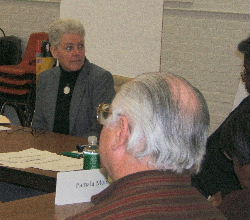
DEP Commissioner McCarthy listens to the Newhall Advisory Committee last night.
Going around the table, committee members asked McCarthy questions and told her what it's been like.
"Families are in limbo. They don't know what to do," said Sheila Epps. "A lot want to know when the cleanup will be and what it will be like during the cleanup." She said a Jewish cemetery is next to her house and "I don't know if these people realize that the land could be contaminated."
McCarthy took notes.
Carol Smith said she bought her home in '82 and is having a hard time selling it. "You have to let them know the soil is contaminated. Some people don't tell," she said. "Everybody is waiting and waiting and that makes me angry. Who will compensate us [for the lost value]? We have put a lot of money into these house and we want to be compensated."
According to Elizabeth Hayes, the community's sentiments have remained the same over the last six years. "We have been waiting. The hearts and minds of the community have not changed," she said.
Total cleanup. No dumping behind the middle school. Hayes was not the first and would not be the last to emphasize those two demands.
Henry Blue said he was peeved that their lawsuit against the town was recently dismissed.
"Who gave Olin [the corporation that now owns Winchester] permission to dump there? So who's to blame? Some of the blame has got to go to the town," he said. "You're telling me the town has no blame in this?"
Leonardo Melendez said nobody wants the family house on Newhall Street. The grandfather died in 1976 of cancer; the grandmother in 2004 of cancer. Contaminants were found on the property.
"We cannot prove she died [from the soil] but she wanted me to be on the [NAC] board," said Melendez.
"I can't let my grandchildren in the back yard," said LaNorma Webb. "It's a nice back yard we can't use."
Henry Platt said houses are sinking.
Pamala Moore asked McCarthy if anything is getting in the way of actually doing the remediation. "I want to get started. I've been here for 50 years. I've had friends die, younger than I am. One was a teacher. A very good teacher and she passed away," said Moore.
When the NAC members finished speaking, Hamid wanted seconds. Chair Conway, a New Haven attorney hired by the state to moderate the NAC, said it was public participation time. Hamid begged to differ.
"The country where I come from is a dictatorship. Nobody stops me from speaking," he said.
"You need to allow others to speak. That's a dictatorship," yelled out Keith Darden from the audience.
"You're out of order," Conway told Darden. "Observers can speak the last 10 minutes of the meeting."
Hamid repeated his earlier performance to McCarthy. And then the public got its 10 minutes.
"This has not been going on for five years or 10 years," said Darden of Homelands Terrace. "It's been going on for 20 years. At this rate we'll all be dead" before the remediation is done.
He said he sent a Freedom of Information request to the federal Environmental Protection Agency for documents on the Newhall remediation project. Two weeks ago he got what he asked for.
"It was completely chilling when I came across that," he said of his discovery that a preliminary assessment had been done on the Newhall site on Sept. 12, 1985.
"We want resolution. We want finality. And we want it grounded in science," roared Darden.
"When? Where?" a female voice called out from the back of the room.
"I'm a wreck," said "Doris" who lives off Winchester Avenue. "The windows are broke all around my house." She said her house is sinking. Every time a bus comes down the street it shakes her brick home.
"I'm fed up with all this. I can't even rest in my house. The streets are sinking. My house is sinking," she said.
The people rested.
"There are decisions we have to make before we take the next step," McCarthy responded. She said the lawsuits [in addition to the one against the town, suits were filed against the state and Olin] have delayed the process.
"We have to stop talking about the whole neighborhood and talk about individual homes. Usually when you take on a job this size, usually it takes the federal government," the commissioner said. "This is a very large project for us to take on. We will never get to the finish line with adversity. We have a long way before we'll get to the end of this."
Asked when the work will being, McCarthy said, "I will tell you it's not [going to be] next week."
"You are the only hope the community has," said Hamid, " because you have the money."
Artist Housing Moving Forward

Shenae Draughn and Seila Mosquera, nonprofit developers, stand in front of the old Johnson Perfume Factory on Dixwell Avenue they hope to turn into apartments and stores.
A creative project planned for Highwood may spark neighborhood-wide revitalization
Story and photos by Sharon Bass
The artist colony slated for 953-965 Dixwell Ave. is bringing more than just affordable apartments, a gallery and retail shops. It's bringing hope to the Highwood neighborhood that other blighted areas will be brought back to life as well.
"It's the lynchpin to further redevelopment in the neighborhood," said Economic Development Director Dale Kroop. Highwood Square, the working name of the artist colony, is part of a larger revitalization plan that includes the reuse of the middle school.
Last Oct. 6, the Legislative Council approved the $335,000 sale of the Johnson Wholesale Perfume Company property on Dixwell Avenue to Mutual Housing Association of South Central Connecticut for the artist colony. This is the association's first endeavor in Hamden.
The nonprofit New Haven developer plans to build 27 affordable apartments and 15,000 square feet of retail and gallery/performing arts space. It also bought the building next to the Johnson property, from the Highville Mustard Seed Corporation for $240,000; and 110 Columbus Ave. for $225,000. Mutual plans to rehab the two Dixwell Avenue buildings, construct a new one on the adjacent lot and raze the structure on Columbus for a parking lot.
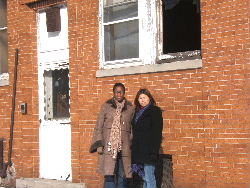
The "disgusting" building purchased from Highville Mustard Seed.
New Haven architect Ben Ledbetter and the Hamden engineering firm of DeCarlo & Doll have been hired. The developer is giving a 2008 completion date.
"It will revive the community and act as a centerpiece for community involvement," said Shenae Draughn, director of real estate development for Mutual Housing. "It will serve as a catalyst for the redevelopment of that area."
Draughn and executive director Seila Mosquera are spearheading the project. It's not their first artist colony. They developed Arlow Loft West in Westville, which opened last year. As will be with the Hamden project, tenants can't be charged more than 30 percent of their income for rent, said Mosquera. But the apartments are not subsidized so renters must be able to pay at least the minimum rent on the sliding scale.
A two-bedroom Arlow Loft apartment, which includes a working studio, ranges from $500-$700, said Mosquera. She expects the same rates in Hamden, adjusted for 2008.
"We are moving away from using vinyl siding and moving to the green materials," said Draughn. She said Highwood Square would be "greenish." Stuff like wood, bamboo flooring, insulation made of fiberglass-free cotton and other biodegradable materials will be used, she said. Highwood Square is being funded through public and private dollars in the form of grants, loans and contributions.
The next step, said Kroop, is for Mutual to submit a design plan to the town. The project will require a special permit because of its size. Kroop said it will probably be on the Planning & Zoning agenda by summer, when there will be a public hearing. If all goes well, he said, "they should have all that in place by September."
The women from Mutual have one more wish for the project. That it will help debunk the stereotyping of affordable housing as public projects.
"The misconception is that it's public housing," said Mosquera. "They have to be able to pay the rent. That's where the misconception comes in. It's not subsidized housing."
Said Draughn: "It's really going to redefine what people think of affordable housing."
Kroop said the rehabilitation costs will be great and the town and state will pitch in.
Mutual is investing over $5 million, the economic development director said. Hamden will put a "substantial portion" of the $335,000 Mutual paid for the building into the rehab. He said the interior of the ramshackle building that Mustard Seed owned is "disgusting. I don't know if we have to go in there with a giant vacuum cleaner to suck everything up," said Kroop.
Getting town and state money is the only way to keep rents affordable, he said. "Otherwise we'd need a Walgreen's. That's exactly what we don't want."
Site designed by Joanne Kittredge

Tip Us Off
Send
news tips

